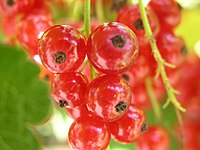
Photo from wikipedia
Litchi fruit contains abundant polyphenols and is susceptible to browning after harvest. Herein the combined treatments of malic acid (MA) and lycopene (LYC) to delay the development of browning in… Click to show full abstract
Litchi fruit contains abundant polyphenols and is susceptible to browning after harvest. Herein the combined treatments of malic acid (MA) and lycopene (LYC) to delay the development of browning in litchi fruit stored at room temperature (25°C) and low temperature (4°C) was investigated. The results showed that the pericarp browning could be alleviated, and the increase of malondialdehyde (MDA) content and relative leakage rate was retarded by the combined MA and LYC during storage. As compared to control, the content of pericarp anthocyanins, flavonoids, and the total phenols maintained higher levels; and the decrease of antioxidant activity of 2,2-diphenyl-1-picrylhydrazyl (DPPH) radical scavenging capacity and reducing power were slowed down in treated fruit. The enzyme activity of polyphenol oxidase (PPO) and peroxidase (POD) related to oxidation of polyphenols were depressed by the combined treatments. Furthermore, correlation analysis revealed that the content of phenols in the pericarp negatively affected the changes in the browning index, and was positively related to the DPPH radical scavenging capacity. Taken together, the combined treatments of MA and LYC exhibited potential effects in delaying the pericarp browning of litchi fruit by maintaining the content of polyphenols, antioxidant activity, and membrane integrity.
Journal Title: Frontiers in Nutrition
Year Published: 2022
Link to full text (if available)
Share on Social Media: Sign Up to like & get
recommendations!